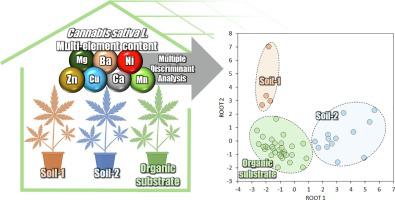Forensic Chemistry ( IF 2.6 ) Pub Date : 2021-02-13 , DOI: 10.1016/j.forc.2021.100319 Mauro Sander Fett , Roberta Fogliatto Mariot , Rafael Scorsatto Ortiz , Tales Tiecher , Flávio Anastácio de Oliveira Camargo

|
Brazil plays a significant role in the cultivation and production of marijuana. The Brazilian Federal Police (BFP) statistics demonstrate an increase in the apprehension of ready-to-use marijuana and cannabis seeds, indicating that indoor cultivation is becoming more common. The present research aimed to test the use of multi-element content in vegetal tissue samples as an indicator of soil or substrate cultivation and, more specifically, to determine whether it is possible to differentiate cannabis plants grown in different soil types. To do so, seeds seized by the Brazilian postal authorities were germinated and cultivated indoor under controlled conditions by the BFP. Then, cannabis plants were grown in two soil (Ultisol and Chernosol) and one substrate comprising organic soil, earthworm humus, and sand. In total, forty-nine (49) cannabis plant samples were analyzed. After digestion, 19 elements were analyzed by inductively-coupled plasma optical emission spectrometry (ICP-OES), and the data were compared by the Kruskal-Wallis H test followed by a multiple discriminant analysis (MDA) to classify samples cultivated with different types of soil and substrate. The model correctly classified 100% of samples in their respective group with an uncertainty of ≤ 2.2%. The MDA demonstrated that manganese, nickel, calcium, magnesium, barium, copper, and zinc were the best set of elements to discriminate Cannabis plants grown in different soil types or substrates. Therefore, the multi-element content of the plant material combined with a robust statistical tool can be applied as an indicator of the type of soil or substrate used to cultivate marijuana.
中文翻译:

使用植物组织中的多种元素含量作为种植大麻的土壤或基质类型的指标(大麻)
巴西在大麻的种植和生产中发挥着重要作用。巴西联邦警察(BFP)的统计数据表明,即食型大麻和大麻种子的忧虑有所增加,这表明室内种植正变得越来越普遍。本研究旨在测试植物组织样品中多元素含量作为土壤或基质栽培指示剂的用途,更具体地说,是确定是否有可能区分在不同土壤类型中生长的大麻植物。为此,BFP在受控条件下将巴西邮政当局扣押的种子发芽并在室内种植。然后,将大麻植物种植在两种土壤(Ultisol和Chernosol)中,一种基质包括有机土壤,worm腐殖质和沙子。总共,分析了四十九(49)个大麻植物样品。消化后,通过电感耦合等离子体发射光谱法(ICP-OES)分析了19种元素,并通过Kruskal-Wallis H检验和随后的多判别分析(MDA)对数据进行了比较,以对使用不同类型的土壤和基质。该模型正确分类了各自组中100%的样本,不确定度≤2.2%。MDA表明,锰,镍,钙,镁,钡,铜和锌是区分生长在不同土壤类型或基质上的大麻植物的最佳元素。因此,植物材料中的多种元素含量与强大的统计工具相结合,可以用作种植大麻的土壤或基质类型的指标。











































 京公网安备 11010802027423号
京公网安备 11010802027423号